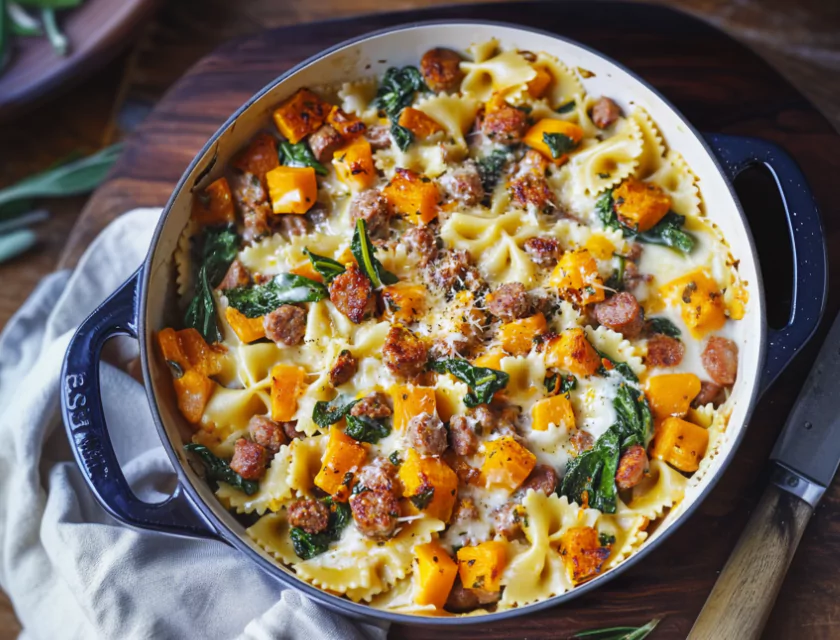Creamy Roasted Butternut Squash Pasta is a rich, flavorful, and comforting dish that combines the natural sweetness of butternut squash with the smooth texture of pasta. This dish is perfect for cozy nights, dinner parties, or meal prepping, as it offers a satisfying blend of creamy, savory, and slightly sweet flavors.

This recipe is particularly appealing because of the balance it strikes between indulgence and nutrition. Butternut squash is packed with vitamins A and C, fiber, and antioxidants, making it a healthy alternative to traditional cream-based pasta sauces. The roasting process enhances its natural sweetness and deepens its flavor, while the addition of garlic and shallots creates an aromatic base.
With just a few ingredients, you can transform this humble vegetable into a luxurious pasta sauce. The key lies in proper preparation, from roasting the squash to blending it into a smooth, velvety sauce. Whether you’re a beginner or a seasoned cook, this guide will walk you through everything you need to know to make the best Creamy Roasted Butternut Squash Pasta.
Overview of Creamy Roasted Butternut Squash Pasta
What Makes This Dish Special?
- Creamy Without Heavy Cheese – Unlike traditional Alfredo or carbonara sauces, this recipe achieves creaminess through blended roasted squash rather than relying heavily on cheese or butter.
- Nutrient-Rich – Butternut squash is loaded with fiber, vitamins A and C, and potassium.
- Easy to Customize – Works well with different pasta types, proteins, and dairy-free alternatives.
- Seasonal Comfort Food – Perfect for fall and winter, but delicious year-round.
Who Will Love This Recipe?
- Vegetarians and Flexitarians – A great meatless dish with optional add-ins.
- Busy Home Cooks – Requires minimal ingredients and simple cooking steps.
- Health-Conscious Eaters – A nutrient-rich meal with fewer calories than traditional cream-based pasta.
- Food Enthusiasts – If you love trying unique pasta dishes, this is a must-try.
A Brief History of Butternut Squash in Cooking
Butternut squash has long been a staple in cuisines around the world, particularly in Native American, Italian, and Mediterranean cooking. Originating from the Americas, winter squashes like butternut have been cultivated for thousands of years for their versatility and long shelf life.
In Italian cuisine, squash is often paired with pasta or risotto, offering a naturally sweet contrast to rich, savory ingredients like cheese and herbs. The idea of using pureed squash as a creamy sauce alternative has gained popularity in modern cooking as a healthier and more flavorful substitute for heavy cream-based sauces.
The rise of plant-based eating has also contributed to the popularity of butternut squash pasta dishes, as they provide a satisfying texture and depth of flavor without relying on dairy-heavy ingredients.
Preparation Phase & Tools to Use
Before diving into the cooking process, it’s essential to prepare properly. The right tools and ingredients will ensure that the recipe turns out perfectly every time.
Essential Tools and Equipment
- Baking Sheet – For roasting the squash, shallots, and garlic evenly.
- Parchment Paper – Helps prevent sticking and makes cleanup easier.
- Blender or Food Processor – Necessary for creating a smooth, velvety sauce.
- Large Pot – For boiling pasta.
- Strainer – To drain the pasta while saving some of the starchy cooking water.
- Wooden Spoon or Tongs – For tossing the pasta with the sauce.
Preparation Tips for the Best Results
- Even Roasting – Cut the butternut squash into uniform-sized cubes for even cooking.
- Roast at High Heat – A temperature of 425°F (220°C) helps caramelize the squash, intensifying its flavor.
- Use Fresh Garlic & Shallots – Roasting them with the squash enhances the depth of flavor.
- Blend Until Completely Smooth – A high-speed blender works best, but a food processor can also get the job done.
- Save the Pasta Water – The starchy water helps thin the sauce while making it cling to the pasta better.
Ingredients List
Main Ingredients:
- 1 medium butternut squash, peeled and cut into 2-inch cubes (about 4 cups once cubed)
- 2 shallots, halved
- 4 cloves garlic, peeled
- 2 tablespoons olive oil
- 1 ½ cup chicken stock (or vegetable stock for a vegetarian version)
- 1 lb spaghetti (or preferred pasta type)
- ½ cup heavy cream (or full-fat coconut milk for a dairy-free alternative)
- Pinch of ground nutmeg
- Kosher salt and freshly cracked black pepper, to taste
For Serving:
- Grated pecorino (or Parmesan cheese)
- Fresh herbs like thyme, basil, chives, or parsley
Step-by-Step Cooking Instructions
Step 1: Roast the Butternut Squash
- Preheat your oven to 425°F (220°C).
- Line a baking sheet with parchment paper.
- Spread the butternut squash cubes, shallots, and garlic evenly on the sheet.
- Drizzle with olive oil and season with salt and pepper. Toss to coat.
- Roast for 25-30 minutes, flipping halfway through, until the squash is fork-tender and slightly caramelized.
Step 2: Cook the Pasta
- While the squash is roasting, bring a large pot of salted water to a boil.
- Cook the pasta until al dente (according to package instructions).
- Reserve ½ cup of pasta water, then drain the pasta.
Step 3: Blend the Sauce
- Transfer the roasted squash, shallots, and garlic to a blender or food processor.
- Add chicken stock and blend until smooth.
- Pour in the heavy cream and add a pinch of nutmeg. Blend again until well combined.
- Taste and adjust seasoning as needed. If the sauce is too thick, add a bit more stock or pasta water.
Step 4: Combine Pasta and Sauce
- In a large pan or the pasta pot, add the drained pasta.
- Pour in a few large spoonfuls of sauce and toss to coat.
- Add more sauce gradually, mixing until the pasta is fully coated.
- If the sauce is too thick, add a little reserved pasta water to loosen it.
Step 5: Serve and Garnish
- Plate the pasta and sprinkle with grated pecorino.
- Garnish with fresh herbs and a final crack of black pepper.
- Serve immediately and enjoy!
Notes & Variations
- Dairy-Free Option: Substitute heavy cream with full-fat coconut milk or cashew cream.
- Gluten-Free Alternative: Use gluten-free pasta made from rice, quinoa, or chickpeas.
- Make It Spicy: Add a pinch of red pepper flakes for some heat.
- Protein Add-Ins: Top with grilled chicken, shrimp, or crispy pancetta for extra protein.
- Cheese Variations: Swap pecorino for goat cheese or smoked gouda for a different twist.
The Best Side Dishes for Butternut Squash Pasta
Pairing your Creamy Roasted Butternut Squash Pasta with the right side dish can elevate the meal, adding texture, contrast, and additional flavors. Here are some of the best complementary sides:
1. Parmesan Roasted Broccoli
- Roasted broccoli with olive oil, garlic, and Parmesan creates a crispy and cheesy contrast to the creamy pasta.
- The slight bitterness of broccoli balances the sweetness of the butternut squash.
2. Garlic Butter Mushrooms
- Sautéed mushrooms bring an umami depth to the meal.
- The earthy and rich taste complements the creamy pasta beautifully.
3. Balsamic Glazed Brussels Sprouts
- The tanginess from balsamic vinegar cuts through the richness of the sauce.
- Roasting Brussels sprouts caramelizes them, adding a sweet-savory crunch.
4. Homemade Garlic Bread
- A crispy slice of garlic bread is perfect for scooping up any leftover sauce.
- The buttery, garlicky flavor enhances the overall meal.
5. Spinach & Arugula Salad with Lemon Dressing
- A light and refreshing salad balances out the richness of the pasta.
- The acidity from lemon dressing helps cleanse the palate between bites.
6. Roasted Cherry Tomatoes with Balsamic Vinegar
- The juicy, slightly charred tomatoes provide a burst of acidity.
- The sweetness of roasted tomatoes complements the butternut squash.
7. Butternut Squash Ravioli in Brown Butter Sauce
- If you love squash, doubling down with a ravioli dish works well.
- Brown butter adds a rich, nutty flavor to accompany the pasta.
8. White Cheddar Mac & Cheese
- For those who love extra cheesiness, this side dish adds another layer of creamy goodness.
- The sharpness of white cheddar contrasts well with the mild sweetness of butternut squash.
Nutritional Information & Health Benefits
Macronutrient Breakdown Per Serving (Approximate)
- Calories: Moderate, depending on portion size and cream content.
- Carbohydrates: Primarily from pasta, but squash provides fiber-rich complex carbs.
- Protein: Moderate, but can be increased with added cheese, nuts, or meat.
- Fats: Healthy fats from olive oil, with additional fat from cream and cheese.
Why Butternut Squash Is a Superfood
- Rich in Vitamin A – Boosts immune function and supports eye health.
- High in Fiber – Aids digestion and promotes gut health.
- Packed with Antioxidants – Helps fight inflammation and supports overall wellness.
- Low in Calories – Compared to traditional cream-based pasta sauces, this dish is a lighter option.
Healthier Substitutions
- Swap Heavy Cream for Greek Yogurt or Coconut Milk – Reduces saturated fat while maintaining creaminess.
- Use Whole Wheat or Chickpea Pasta – Increases fiber and protein.
- Reduce Cheese or Use Nutritional Yeast – For a lower-fat, dairy-free option.
- Add Greens Like Kale or Spinach – Boosts iron and fiber content.
Common Mistakes to Avoid & Pro Tips
Even simple recipes have potential pitfalls. Avoid these mistakes to get the best results.
Mistakes to Avoid
1. Over-Roasting or Under-Roasting the Squash
- Over-roasting can dry out the squash, making it difficult to blend smoothly.
- Under-roasting leaves the squash too firm, affecting the sauce’s texture.
- Tip: Roast at 425°F for a balanced caramelization without drying.
2. Not Blending the Sauce Properly
- A chunky sauce can ruin the creamy texture.
- Using a low-powered blender may not achieve the silky consistency needed.
- Tip: A high-speed blender or immersion blender ensures a smooth sauce.
3. Forgetting to Save Pasta Water
- Starchy pasta water helps emulsify the sauce, making it cling better to the pasta.
- Without it, the sauce may turn out too thick or separate.
- Tip: Reserve at least ½ cup before draining.
4. Overcooking or Undercooking the Pasta
- Overcooked pasta gets mushy, while undercooked pasta won’t absorb the sauce well.
- Tip: Cook until al dente, as pasta will continue cooking when tossed in the sauce.
5. Skipping the Seasoning Adjustment
- Squash has natural sweetness, but without enough salt and acid, the dish may taste bland.
- Tip: Add salt gradually and consider balancing flavors with lemon juice or vinegar.
6. Using Too Much Cream
- Heavy cream can overpower the delicate butternut squash flavor.
- Tip: Start with ½ cup and add more if needed. Coconut milk or Greek yogurt can lighten the dish.
Pro Tips for Making the Best Butternut Squash Pasta
1. Best Types of Pasta to Use
- Spaghetti works well, but for more sauce absorption, try:
- Pappardelle – Wide, flat noodles that hold creamy sauces beautifully.
- Rigatoni or Penne – Tubular shapes trap sauce inside.
- Orecchiette – Little “ears” that scoop up the thick sauce.
2. Adding a Smoky Element
- A pinch of smoked paprika or crisped pancetta enhances the dish.
- Smoked cheeses like gouda can also bring depth.
3. Making It Extra Creamy Without Heavy Cream
- Blend in soaked cashews for a creamy, dairy-free alternative.
- Add ricotta or Greek yogurt for richness without excess fat.
4. Using Different Cheeses for Depth
- Goat cheese – Adds tangy creaminess.
- Smoked gouda – Introduces a deep, rich flavor.
- Parmesan or Pecorino – Adds saltiness and umami.
5. Vegan & Dairy-Free Modifications
- Replace heavy cream with full-fat coconut milk or cashew cream.
- Use nutritional yeast instead of cheese for a cheesy flavor.



Leave a Comment